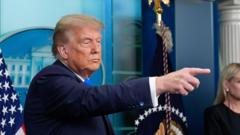In the bustling garment factories of Guangzhou, a storm brews as U.S. tariffs on imports hit hard, forcing makers of affordable apparel to reassess their futures.
### Shifting Sands: China’s Garment Industry Faces Crisis Amid Tariff Changes

### Shifting Sands: China’s Garment Industry Faces Crisis Amid Tariff Changes
As U.S. tariffs take their toll, Chinese clothing manufacturers must pivot to new markets or risk collapse.
Liu Miao, a small factory owner who has thrived for years by selling clothes on Amazon, finds his dreams dwindling under the weight of rising costs and new trade barriers. “You can’t sell anything to the United States right now,” he laments, reflecting the dire situation for many in China's once-vibrant garment industry.
For years, businesses like Liu's flourished under e-commerce platforms such as Shein and Temu, which opened up American markets and relied on tax loopholes. However, the recent imposition of high tariffs and a new tax regime have gutted profits, rendering usual practices unsustainable. Historically, access to the U.S. market allowed these manufacturers to be competitive, with fees waived for items valued at less than $800.
But as tariffs rise, hundreds of factories are grappling with severe profitability issues. "I was making about a dollar on each garment, but now I'm down to 50 cents," Liu explains, stressing the increasing pressure from labor and production costs in a crowded market.
In the shadow of a weakened trade relationship, the factory floors that thrived on high-volume orders are increasingly silent, giving way to uncertainty. The lure of profits that previously parked luxury vehicles outside factories has dimmed considerably. As trade tensions further deteriorate the bond between the world’s two largest economies, many in Guangzhou cling to hope for new trading partners or affordable offshore sites to stay afloat.
The evolving landscape of international trade continues to put pressure on small manufacturers, leaving them at a critical crossroads in the wake of immense economic challenges. The future of their livelihoods hinges on navigating this new reality—one where the ability to sell internationally may depend on adopting entirely new strategies and finding innovative ways to cut costs.
For years, businesses like Liu's flourished under e-commerce platforms such as Shein and Temu, which opened up American markets and relied on tax loopholes. However, the recent imposition of high tariffs and a new tax regime have gutted profits, rendering usual practices unsustainable. Historically, access to the U.S. market allowed these manufacturers to be competitive, with fees waived for items valued at less than $800.
But as tariffs rise, hundreds of factories are grappling with severe profitability issues. "I was making about a dollar on each garment, but now I'm down to 50 cents," Liu explains, stressing the increasing pressure from labor and production costs in a crowded market.
In the shadow of a weakened trade relationship, the factory floors that thrived on high-volume orders are increasingly silent, giving way to uncertainty. The lure of profits that previously parked luxury vehicles outside factories has dimmed considerably. As trade tensions further deteriorate the bond between the world’s two largest economies, many in Guangzhou cling to hope for new trading partners or affordable offshore sites to stay afloat.
The evolving landscape of international trade continues to put pressure on small manufacturers, leaving them at a critical crossroads in the wake of immense economic challenges. The future of their livelihoods hinges on navigating this new reality—one where the ability to sell internationally may depend on adopting entirely new strategies and finding innovative ways to cut costs.




















